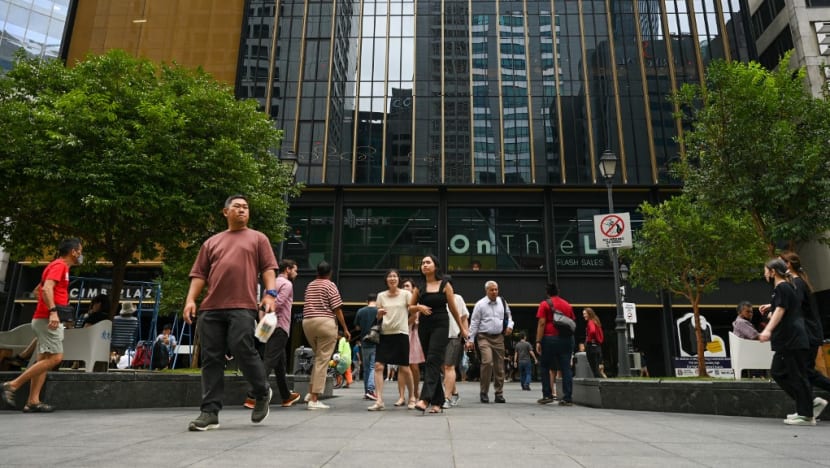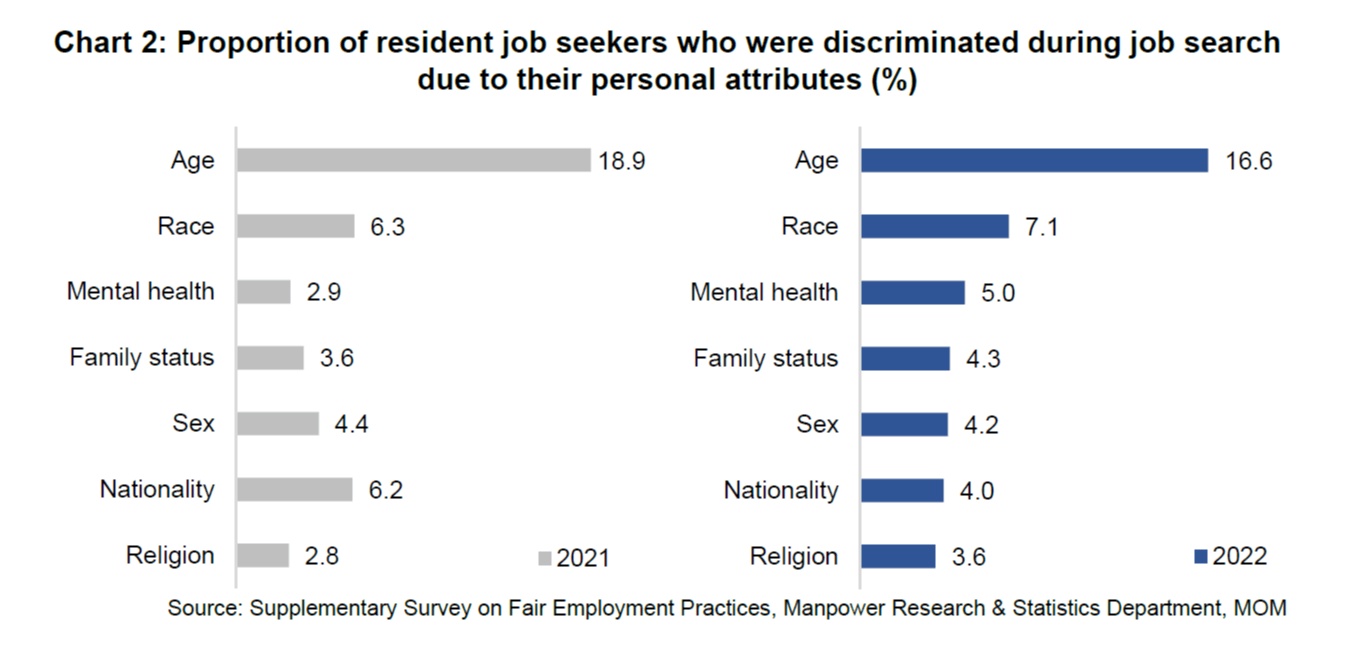Fewer jobseekers, employees faced discrimination in 2022: MOM

A lunchtime crowd is seen at Raffles Place in Singapore on Oct 6, 2022. (File photo: AFP/Roslan Rahman)
SINGAPORE: Fewer Singapore residents in the labour force faced discrimination at work and during their job searches last year, the Ministry of Manpower (MOM) said on Monday (Jul 31).
More jobseekers and employees did, however, experience discrimination based on mental health, according to MOM's Fair Employment Practices Report for 2022.
The report revealed that 8.2 per cent of workers experienced discrimination at the workplace, down from 8.5 per cent in 2021, while 23.8 per cent of jobseekers experienced discrimination, down from 25.8 per cent.
This compares with figures of 24.1 per cent among employees and 42.7 per cent among jobseekers in MOM's 2018 report.
"The continued improvement follows efforts by MOM, TAFEP and tripartite partners to promote fair employment practices," MOM said, referring to the Tripartite Alliance for Fair and Progressive Employment Practices.
DISCRIMINATION EXPERIENCED BY JOBSEEKERS
Age (16.6 per cent), race (7.1 per cent) and mental health (5 per cent) discrimination were the most common forms of discrimination encountered during job searches, MOM said.
"While age discrimination remained the main form of discrimination towards jobseekers, the proportion of jobseekers who experienced age discrimination declined, from 18.9 per cent in 2021 to 16.6 per cent in 2022," MOM said.
There were, however, slight rises in discrimination based on race – 6.3 per cent to 7.1 per cent – and mental health – 2.9 per cent to 5 per cent.
MOM said that the rise in mental health discrimination "could be partly due to greater expectations for employers to care for their staff's mental needs, as well as an increase in the proportion of residents in the labour force with mental health conditions".
The ministry noted that there had been "a rise in the prevalence of poor mental health among residents aged 18 to 74" between 2017 and 2020.
Jobseekers also faced discrimination based on family status (4.3 per cent), sex (4.2 per cent), nationality (4 per cent) and religion (3.6 per cent).

Family status discrimination included discrimination based on marital status, pregnancy status and maternal reasons.
Discrimination based on maternal reasons saw a notable increase from 6.9 per cent in 2021 to 14.9 per cent in 2022, while discrimination based on pregnancy status also went up from 4.2 per cent to 6.9 per cent, MOM data showed.
Discrimination based on marital status dipped, however, from 3.2 per cent to 2.6 per cent.

MOM said that the most common source of discrimination faced by jobseekers was "job advertisements which stated a preference for specific demographic characteristics without justifications".
"However, the proportion of jobseekers who indicated this form of discrimination has declined from 43.3 per cent in 2021 to 33.9 per cent in 2022, as more employers adhere to the (Tripartite Guidelines on Fair Employment Practices) which encourages employers to ensure that job advertisements state job-related criteria that are related to the qualifications, skills, knowledge and experience of the candidates," the ministry said.
Requests by employers for personal information that was not relevant to the job – such as age, marital status and nationality – was another form of discrimination commonly experienced by jobseekers, MOM added.
Fewer Singapore residents in the labour force faced discrimination at work and during their job searches last year, the Ministry of Manpower (MOM) said on Monday (Jul 31).
DISCRIMINATION EXPERIENCED BY EMPLOYEES
The most common forms of discrimination faced by jobseekers were also the top forms of discrimination experienced at work, although mental health (4.7 per cent) accounted for the highest proportion ahead of age (3.7 per cent) and race (2.6 per cent).
While the figures for discrimination based on age and race were down from the 4.6 per cent and 2.8 per cent reported in 2021, discrimination based on mental health rose from a figure of 3.2 per cent that year.
Other leading forms of discrimination faced by employees were discrimination based on disability (2.5 per cent), nationality (2.5 per cent), family status (2 per cent), sex (1.9 per cent) and religion (1.5 per cent).
"Employees who experienced discrimination more commonly reported unfair treatment related to remuneration, workload distribution and career progression," MOM said.
"Females were more likely than males to experience discrimination at work, which commonly occurred through unequal distribution of workload," the ministry added.
"Non-tertiary educated females were also more likely to experience pay-related discrimination than their male counterparts.
"This suggests that, in general, females need more support for fairer pay and work conditions."

MORE SEEKING HELP
More employees reported that their firms had put in place formal procedures to manage workplace discrimination in 2022 (59.8 per cent), up from 54 per cent in 2021 and 49.6 per cent in 2018, data showed.
"The encouraging trend could lead to further improvements in workplace fairness in the future," MOM said.
The proportion of employees who sought help after facing discrimination at work rose significantly from 20 per cent in 2021 to 35.3 per cent in 2022.
"The majority of employees who sought help with discrimination were able to do so via the formal help provided by their firm or their union," MOM said.
"Among those who chose not to seek help, the most common reasons were 'fear of being marginalised at work or affecting work relations negatively' as well as having 'repercussions on career'," the ministry added.
"These findings signal the importance of having a formal, confidential and impartial process to handle workplace grievances, so as to create a safe environment for employees to report discrimination."
The Fair Employment Practices Report 2022 was based on a survey conducted by the Manpower Research and Statistics Department of MOM from Oct 10, 2022, to Feb 10, 2023.
A total of 3,600 Singapore residents in the labour force aged 15 and over excluding full-time National Servicemen were selected at random to participate in the survey, of whom 80.3 per cent responded.

















